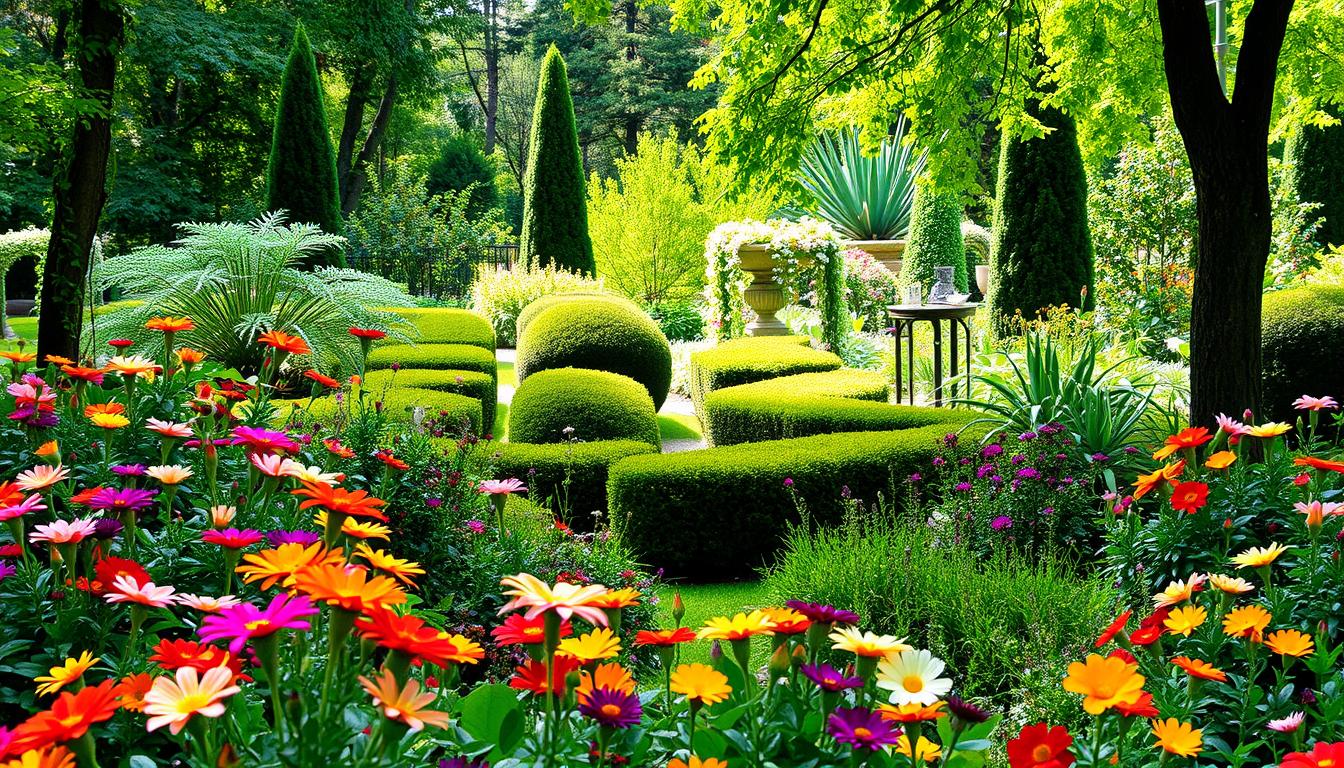Creating a stunning outdoor space starts with thoughtful planning. A well-designed yard not only enhances your home’s curb appeal but also provides a relaxing retreat for you and your family. By focusing on strategic choices, you can maximize both beauty and functionality.
Seasonal adaptability is a key factor in achieving a vibrant outdoor area year-round. Whether you’re working with a small patio or a sprawling lawn, optimizing space ensures every corner feels purposeful. From colorful blooms to structured layouts, the possibilities are endless.
In this article, we’ll explore 15 actionable ideas to transform your yard into a breathtaking oasis. These tips will not only boost your property’s value but also bring you joy every time you step outside. Let’s dive in and discover how to make your outdoor space truly shine.
Key Takeaways
- Intentional planning is essential for a beautiful and functional yard.
- Strategic planting enhances aesthetics and maximizes space.
- Seasonal adaptability keeps your outdoor area vibrant year-round.
- Optimizing space ensures every corner feels purposeful.
- Well-designed yards increase property value and personal enjoyment.
Introduction to Garden Planting Design
A thoughtfully planned outdoor area can transform your home’s aesthetic and functionality. By focusing on intentional choices, you can create a space that’s both beautiful and practical. Let’s explore why this approach matters and the benefits it brings.
Why Garden Design Matters
Intentional design prevents chaotic plant growth, ensuring every element has a purpose. It also helps align plant selection with your home’s architectural style, creating a cohesive look. This approach not only enhances curb appeal but also supports local wildlife by providing habitats.
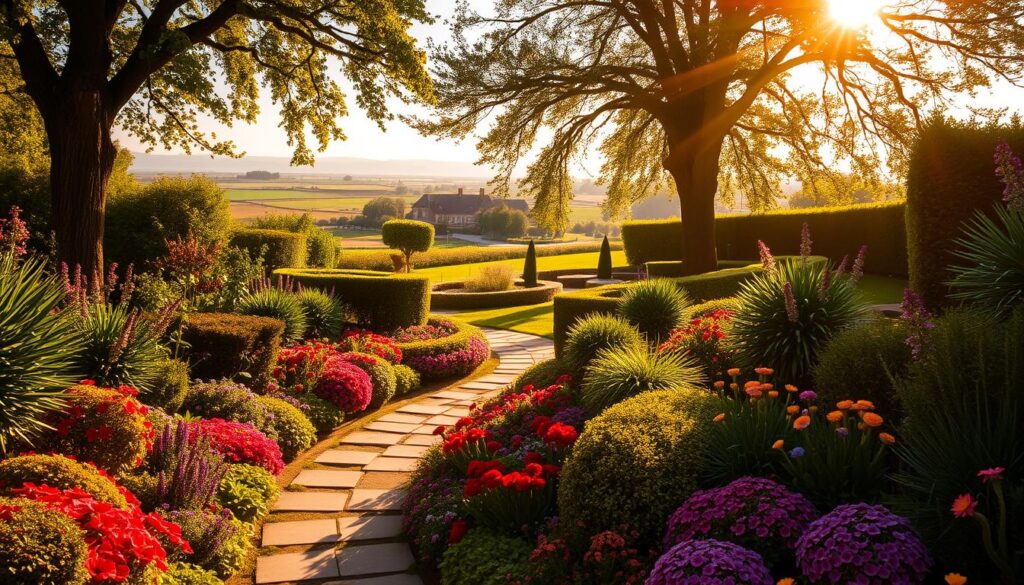
Benefits of a Well-Designed Garden
A well-planned landscape offers numerous advantages. It saves time and money by reducing maintenance needs and preventing costly mistakes. Additionally, it boosts your property’s value and creates a welcoming environment for family and guests.
| Benefit | Description |
|---|---|
| Improved Curb Appeal | Enhances the visual attractiveness of your property. |
| Wildlife Support | Provides habitats for birds, bees, and other creatures. |
| Cost Savings | Reduces long-term maintenance and replanting expenses. |
For professional insights, consider exploring resources like Proven Winners’ Garden Design Webinars. These tools can help you refine your approach and achieve stunning results.
1. Start with a Plan: Mapping Your Garden Space
Mapping your space is the first step to achieving a functional and beautiful yard. A clear plan helps you visualize the layout and ensures every area serves a purpose. Start by assessing your yard’s unique features, such as sunlight patterns and soil quality.
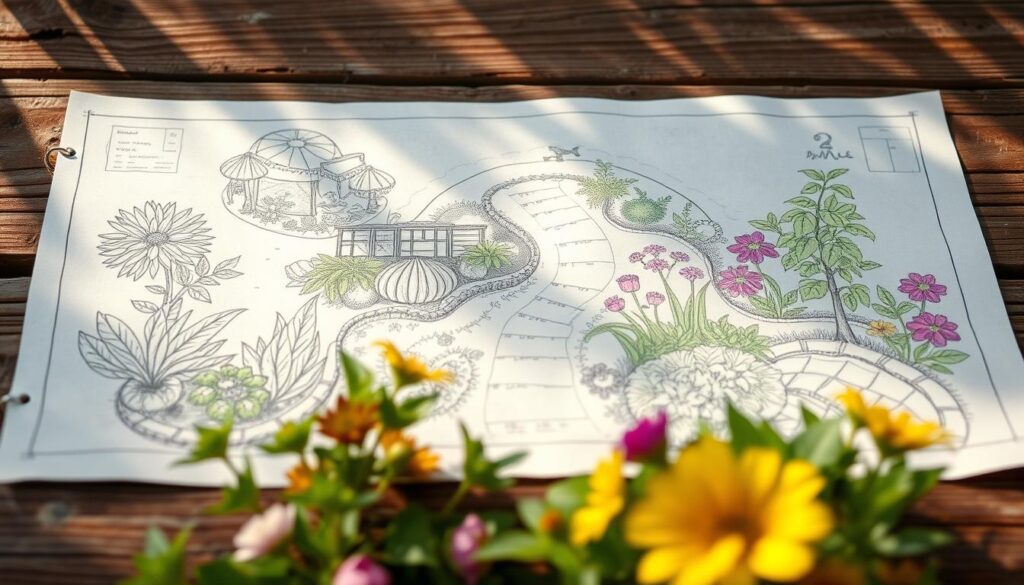
Assessing Your Yard’s Layout
Begin by observing how sun moves across your yard throughout the day. This helps identify areas with full sun, partial shade, or full shade. Next, test your soil to determine its pH and nutrient levels. These steps are crucial for selecting plants that will thrive in your specific conditions.
Consider your USDA hardiness zone and microclimate. These factors influence which plants are best suited for your area. Tools like graph paper or digital apps, such as Gardenary’s planning methods, can help you create a detailed layout.
Choosing the Right Plants for Your Space
Select plants based on the light and soil conditions of your yard. For sunny spots, opt for sun-loving varieties like lavender or marigolds. Shady areas are perfect for ferns or hostas. Starter plants are a great choice for beginners, as they’re easier to care for and establish quickly.
Companion planting is another strategy to maximize growth. Pairing plants that benefit each other, like tomatoes and basil, can improve health and yield. With a well-thought-out plan, your outdoor space will flourish and bring joy for years to come.
2. Incorporate Trellises for Vertical Growth
Maximize your outdoor area by adding trellises for vertical growth. These structures not only save up to 50% of space but also improve air circulation around your plants. Whether you have a small patio or a large yard, trellises can add both functionality and beauty to your landscape.

Best Plants for Trellises
Certain plants thrive when grown vertically. Tomato varieties like ‘Sun Gold’ are excellent choices for trellises, as they produce abundant fruit and require support. Flowering vines, such as clematis or morning glories, add vibrant blooms and create a stunning visual effect. For a mix of beauty and utility, consider combining edible and ornamental varieties.
How to Install and Maintain Trellises
Installing a trellis is straightforward but requires attention to detail. Ensure the structure is anchored at least 18 inches deep for stability. Choose materials based on your needs: metal trellises are durable and modern, while wooden ones offer a rustic charm. Here’s a quick comparison:
| Material | Pros | Cons |
|---|---|---|
| Metal | Durable, weather-resistant | Can be heavy and expensive |
| Wood | Affordable, natural look | Requires regular maintenance |
Seasonal maintenance is key to keeping your trellis in top shape. Prune plants regularly to prevent overgrowth, and inspect the structure for damage after harsh weather. Even in winter, bare trellises can add decorative interest to your garden.
“Vertical gardening is not just a trend; it’s a practical solution for maximizing small spaces and enhancing plant health.”
By incorporating trellises, you can transform your outdoor space into a lush, vertical paradise. With the right design and care, these structures will bring both beauty and functionality to your yard.
3. Create a Low-Maintenance Perennial Garden
A low-maintenance perennial garden is perfect for busy homeowners. With the right plants, you can enjoy a vibrant outdoor space without constant upkeep. Perennials return year after year, saving time and effort while adding beauty to your landscape.
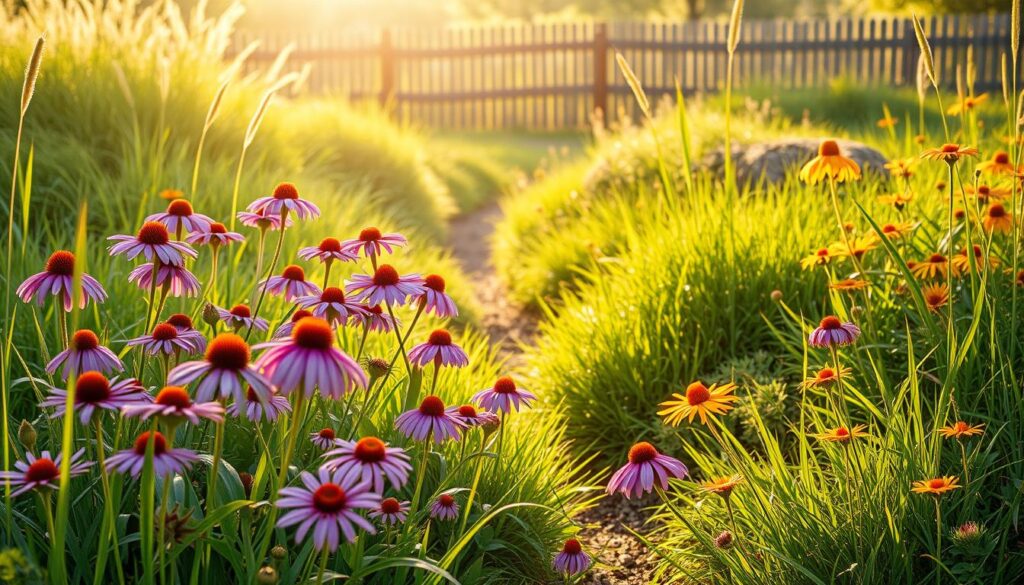
Top Perennials for Easy Care
Choosing the right perennials is key to a hassle-free garden. A drought-tolerant trio like Salvia nemorosa, Nepeta, and Echinacea is ideal. These plants thrive in various conditions and require minimal care.
Layering heights adds visual interest. For example, pair 18-inch catmint with 36-inch Russian sage. This creates depth and ensures every flower gets its moment to shine.
Design Tips for a Low-Maintenance Garden
Mulch is a game-changer for weed suppression. Organic options like wood chips or straw keep soil healthy while reducing maintenance. Proven Winners’ Low-Maintenance Perennial list is a great resource for selecting hardy varieties.
Plan for 3-season blooms to keep your landscape vibrant year-round. Early bloomers like crocus, summer stars like coneflowers, and fall favorites like asters ensure continuous color.
| Perennial | Height | Bloom Season |
|---|---|---|
| Salvia nemorosa | 18-24 inches | Summer |
| Nepeta | 18 inches | Spring to Fall |
| Echinacea | 24-36 inches | Summer to Fall |
“A well-planned perennial garden is a gift that keeps on giving, offering beauty with minimal effort.”
By focusing on easy-care perennials and smart design, you can create a stunning outdoor retreat that thrives with little intervention. Enjoy more time relaxing and less time working in your yard.
4. Design a Sun-Loving Flower Bed
Brighten your yard with a sun-loving flower bed that thrives in full sunlight. These beds are perfect for areas that receive 6-8 hours of direct sun daily. With the right selection and arrangement, you can create a vibrant display that lasts all season.
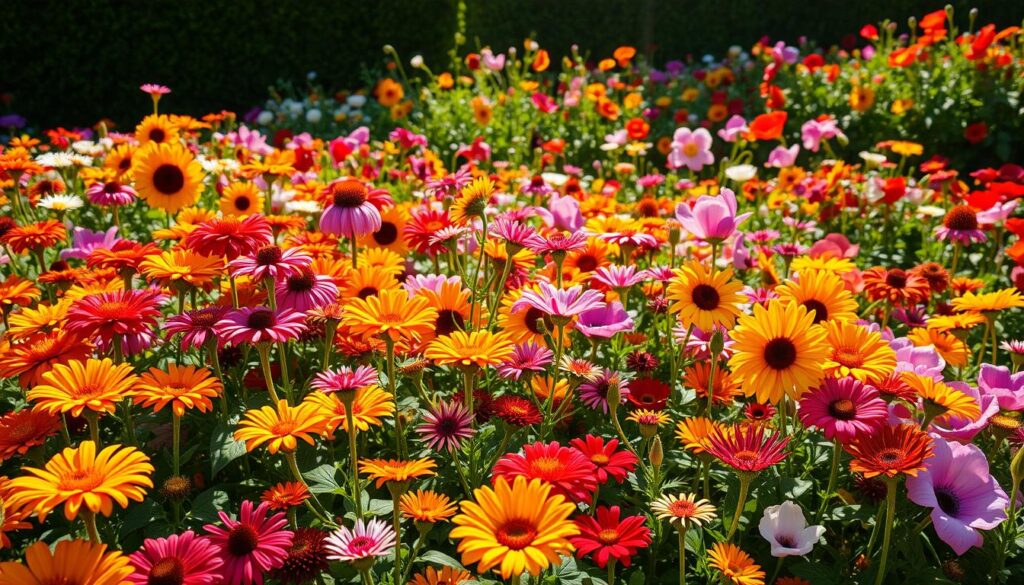
Best Flowers for Full Sun
Choosing the right flowers is essential for a thriving bed. Zinnias, marigolds, and blanket flowers are excellent options. These varieties are heat-resistant and bloom abundantly in sunny conditions. Dahlias and lilies also add bold colors and striking shapes to your display.
For a mix of heights, consider planting shorter varieties like 12-inch portulaca at the front. Taller options like 48-inch hollyhocks work well at the back. This layering creates depth and ensures every flower gets its moment to shine.
Arranging Flowers for Maximum Impact
Arrangement plays a key role in the overall look. Color blocking, where flowers of the same hue are grouped together, creates bold, eye-catching sections. Alternatively, a gradient arrangement transitions smoothly from one color to the next for a softer effect.
Staggering bloom times ensures continuous color. Pair early bloomers with late-season varieties to keep your bed vibrant throughout the year. With thoughtful design, your sun-loving flower bed will become the highlight of your outdoor space.
“A well-planned flower bed not only adds beauty but also brings joy with every bloom.”
5. Transform a Corner with a Fence Garden
Turn an overlooked corner into a vibrant focal point with a fence garden. This creative approach maximizes small spaces and adds a splash of color to your backyard. By combining fast-growing flowers and thoughtful design, you can create a stunning display that enhances your outdoor area.
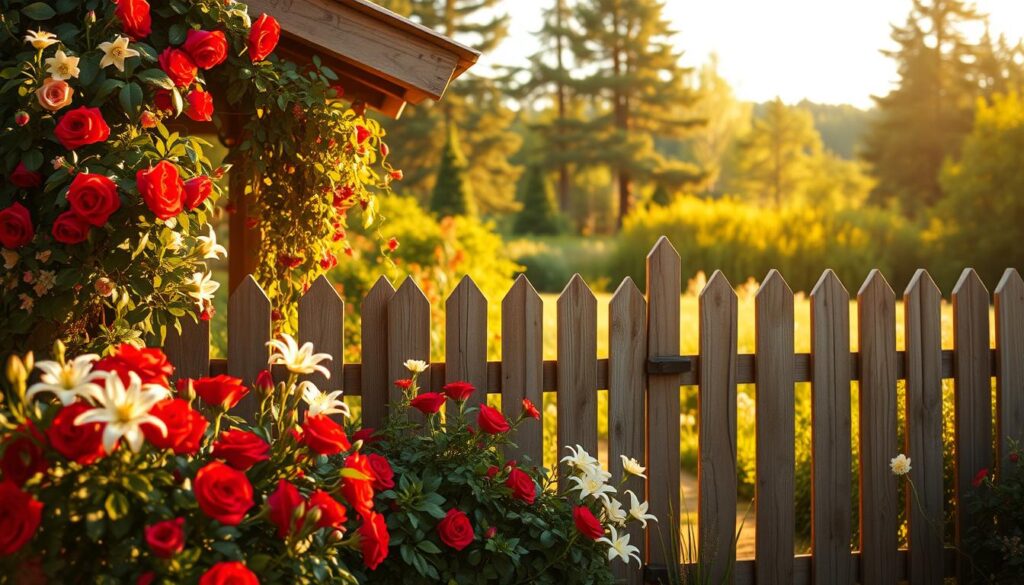
Choosing Fast-Growing Flowers
For quick results, consider annuals like nasturtiums, which mature in just 60 days. These bright blooms are perfect for filling gaps and adding instant charm. Perennial climbers, such as clematis ‘Jackmanii’, offer long-term beauty and vertical interest.
Black-eyed Susans, cosmos, and penstemon are excellent choices for a fence garden. These hardy plants thrive in various conditions and attract pollinators like bees and butterflies. For added appeal, integrate a butterfly bush, a magnet for pollinators and a striking centerpiece.
Designing a Colorful Corner Garden
Color theory plays a key role in small spaces. Use complementary colors, like purple and yellow, to create a harmonious look. Alternatively, a monochromatic scheme with varying shades of one color adds depth and elegance.
Containers are a great way to add flexibility. Place pots of varying heights along the fence to create layers and visual interest. This approach also allows you to easily rearrange plants as needed.
| Plant | Type | Maturity Time |
|---|---|---|
| Nasturtiums | Annual | 60 days |
| Clematis ‘Jackmanii’ | Perennial Climber | 2-3 years |
| Black-eyed Susans | Perennial | 1 year |
“A fence garden is more than just a decorative feature; it’s a dynamic space that brings life and beauty to any corner.”
With the right plants and design, your fence garden will become a cherished part of your outdoor space. Enjoy the vibrant colors and buzzing activity it brings to your backyard.
6. Build a Drought-Tolerant Garden
A drought-tolerant landscape can thrive even in the harshest conditions. By selecting the right plants and using smart techniques, you can create a beautiful, water-efficient outdoor space. This approach not only conserves resources but also reduces maintenance needs.
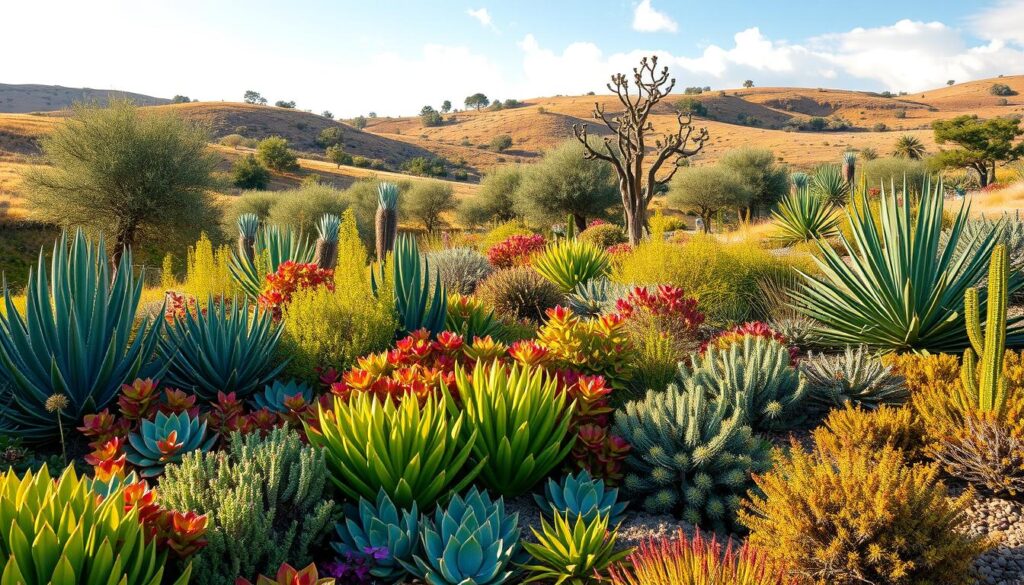
Selecting Drought-Resistant Plants
Choosing the right plants is the foundation of a drought-tolerant landscape. Succulents like Sedum ‘Autumn Joy’ are excellent options. Their fleshy leaves store water, making them resilient in dry conditions. Other great choices include lavender, yarrow, and Russian sage, which thrive with minimal care.
Consider using a mix of pink, purple, yellow, and white perennials for a vibrant display. These colors not only add beauty but also attract pollinators. Always check your USDA drought zone map to ensure your selections are suited to your region.
Water-Saving Design Techniques
Xeriscaping is a key principle for water-efficient landscapes. This method focuses on reducing water use through strategic planning. Start by grouping plants with similar water needs together. This ensures efficient irrigation and prevents overwatering.
Swales, shallow ditches designed to capture and redirect rainwater, are another effective technique. They help retain moisture in the soil, reducing the need for additional watering. Gravel mulch is also a great option. It minimizes evaporation, suppresses weeds, and adds a polished look to your space.
“A drought-tolerant garden is not just about survival; it’s about creating a sustainable and beautiful outdoor retreat.”
By combining drought-resistant plants with smart design techniques, you can build a resilient and stunning outdoor area. Enjoy the benefits of a low-maintenance, eco-friendly landscape that thrives year-round.
7. Add Year-Round Interest with Seasonal Plants
Keeping your outdoor space vibrant throughout the year requires strategic plant choices. By selecting a mix of seasonal plants, you can ensure your landscape remains lively and colorful no matter the time of year. Let’s explore how to achieve this balance.
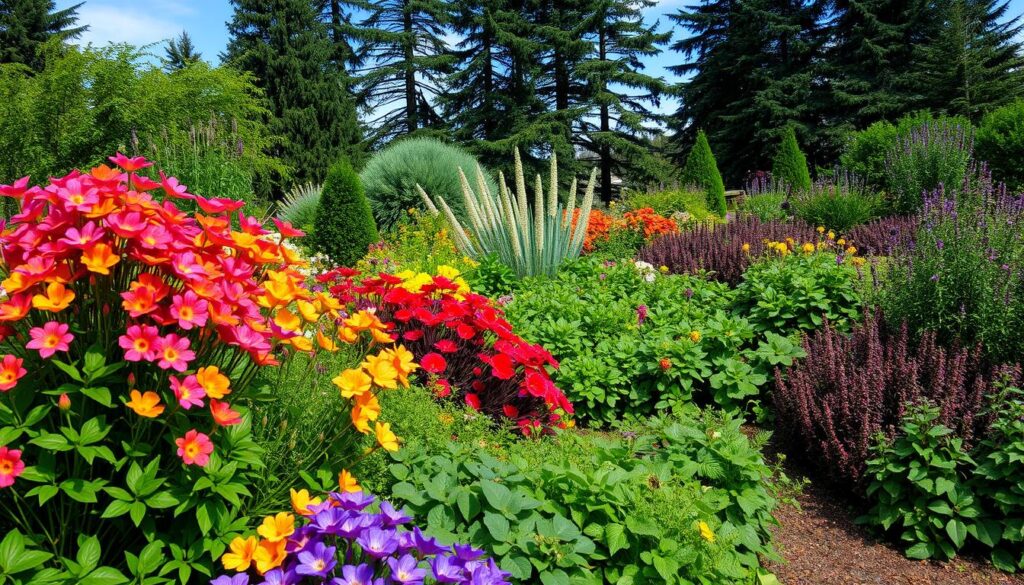
Plants for Spring, Summer, and Fall
Start with spring favorites like Tulip ‘Queen of Night’ paired with cheerful daffodils. These early bloomers bring a burst of color after winter. For summer, Hydrangea paniculata varieties are a great choice. Their large, showy blooms last for months and add a lush feel to your space.
As fall approaches, Chrysanthemum ‘Sheffield Pink’ takes center stage. Its warm hues complement the changing leaves, creating a cozy atmosphere. By layering these plants, you ensure continuous beauty from season to season.
Incorporating Winter Interest
Winter doesn’t have to be dull. Red-twig dogwood adds structural interest with its striking red stems. Evergreen shrubs, like boxwood or holly, provide a green backdrop even in the coldest months. Seed heads from plants like coneflowers offer both visual appeal and a food source for birds.
Evergreen foundation planting is another smart strategy. These plants anchor your landscape and maintain a polished look year-round. Combine them with seasonal accents for a dynamic and inviting outdoor space.
“A well-planned mix of seasonal plants ensures your outdoor area remains a source of joy and beauty all year long.”
8. Design a Garden for Birds and Wildlife
Inviting birds and wildlife into your outdoor area can transform it into a lively ecosystem. By making thoughtful choices, you can create a space that supports biodiversity while adding beauty and charm. Let’s explore how to make your yard a haven for nature.
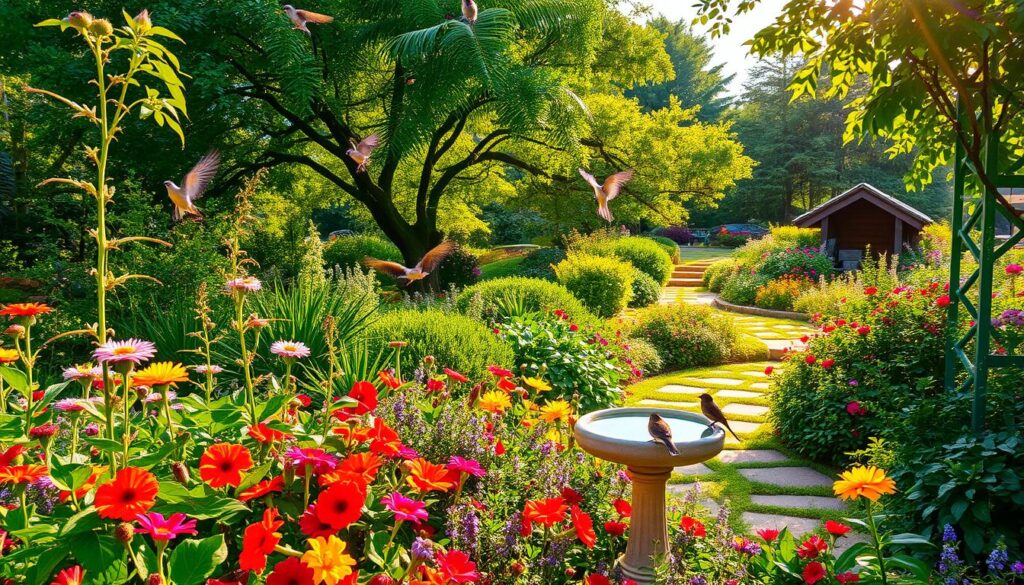
Choosing Bird-Friendly Plants
Selecting the right plants is key to attracting birds. Berry producers like Ilex verticillata (winterberry) provide essential food sources, especially in colder months. Native milkweed is another excellent choice, as it supports monarch butterflies and other pollinators.
Consider adding plants with varying heights and textures. Tall trees offer nesting sites, while shrubs and ground cover provide shelter. A mix of flowering and fruiting plants ensures year-round interest and sustenance for wildlife.
Creating a Habitat for Wildlife
Water features are a great addition, but safety is crucial. Shallow birdbaths or small ponds with gentle slopes allow easy access for birds and small animals. Keep the water clean and fresh to prevent disease.
Brush piles are another simple yet effective way to support wildlife. Place them in quiet corners to offer shelter for birds, insects, and small mammals. Avoid using pesticides, as they can harm the very creatures you’re trying to attract.
| Element | Benefit |
|---|---|
| Berry-Producing Plants | Provide food for birds year-round |
| Native Milkweed | Supports monarch butterflies |
| Water Features | Offer hydration and bathing spots |
| Brush Piles | Create safe shelters for wildlife |
“A wildlife-friendly yard is more than just a beautiful space; it’s a thriving ecosystem that benefits both nature and people.”
By incorporating these elements, you can create a garden that not only looks stunning but also supports the local ecosystem. Enjoy the sights and sounds of birds and wildlife as they make your outdoor area their home.
9. Experiment with Container Gardening
Transform your patio or balcony into a lush retreat with container gardening. This versatile approach allows you to grow plants in any space, making it perfect for urban dwellers or those with limited yard areas. Whether you’re a beginner or an experienced gardener, containers offer endless possibilities for creativity and functionality.
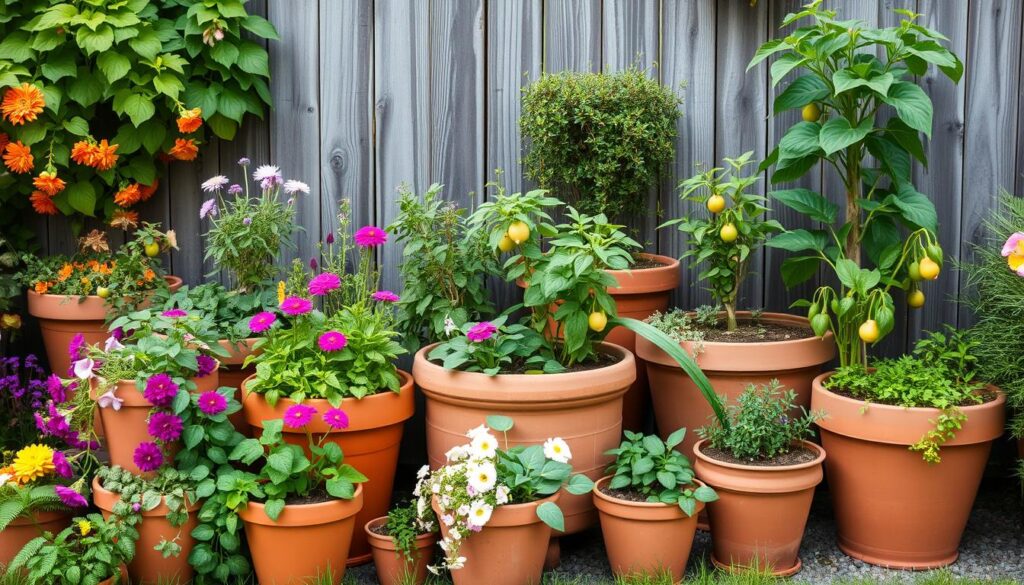
Best Plants for Containers
Choosing the right plants is key to a thriving container garden. Dwarf conifers add structure and year-round interest, while citrus trees bring a touch of the tropics to your patio. For a dynamic arrangement, use the thriller-filler-spiller formula. Start with a bold centerpiece like a tall grass or flowering plant, add medium-sized fillers such as petunias, and finish with trailing spillers like ivy or sweet potato vine.
Self-watering containers are a game-changer for busy homeowners. They reduce the need for frequent watering, ensuring your plants stay healthy with minimal care. Lightweight soil mixes are another essential. They provide proper drainage and prevent containers from becoming too heavy to move.
Designing a Container Garden
Designing a container garden is all about balance and creativity. Group containers of varying heights and sizes to create visual interest. Use complementary colors and textures to make your arrangement pop. For example, pair bold red geraniums with soft green ferns for a striking contrast.
Don’t forget to consider your home’s style. Modern spaces benefit from sleek, geometric containers, while rustic settings shine with terracotta or wooden planters. For more tips on getting started, check out this beginner’s guide to gardening.
“Container gardening is not just about growing plants; it’s about creating a personalized oasis that reflects your style and enhances your outdoor space.”
10. Conclusion: Bringing Your Garden Design to Life
Bringing your outdoor vision to life starts with a clear and actionable plan. Whether you’re transforming a small space or revamping your entire yard, thoughtful steps ensure success. Begin by assessing your area, choosing the right plants, and mapping out your layout.
If you’re new to this, start small. Focus on 3-5 plants that suit your conditions and grow from there. Keeping a journal can help track progress and refine your approach over time. For expert guidance, explore Proven Winners’ Garden Center Finder to locate quality plants near you.
Finally, don’t forget to download Gardenary’s trellis plans to add vertical interest and maximize your space. With patience and creativity, your outdoor area will flourish into a beautiful and functional retreat.

